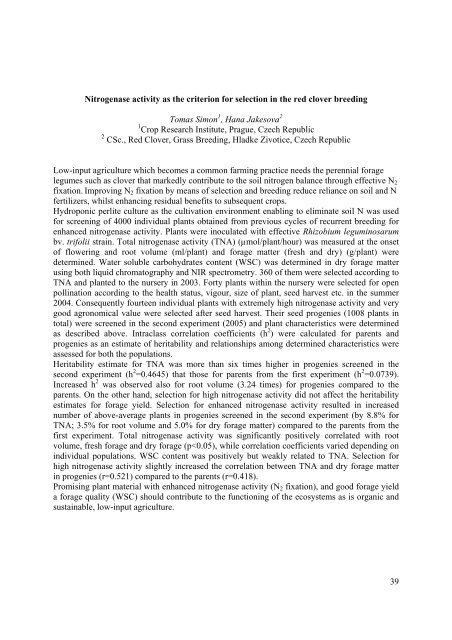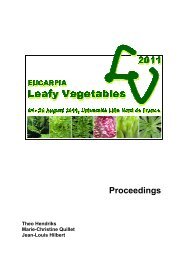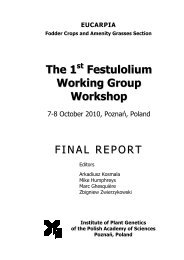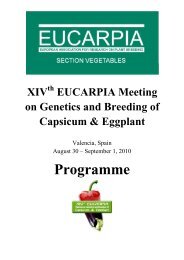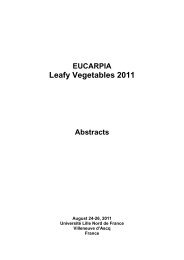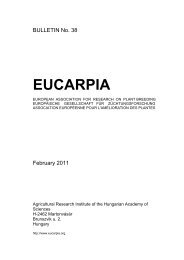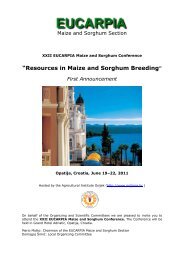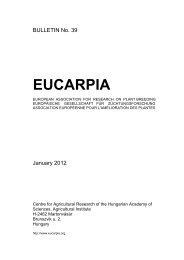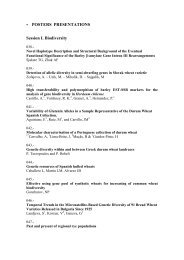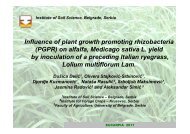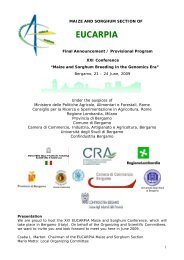Plant breeding for organic and sustainable, low-input agriculture
Plant breeding for organic and sustainable, low-input agriculture
Plant breeding for organic and sustainable, low-input agriculture
Create successful ePaper yourself
Turn your PDF publications into a flip-book with our unique Google optimized e-Paper software.
Nitrogenase activity as the criterion <strong>for</strong> selection in the red clover <strong>breeding</strong><br />
Tomas Simon 1 , Hana Jakesova 2<br />
1 Crop Research Institute, Prague, Czech Republic<br />
2 CSc., Red Clover, Grass Breeding, Hladke Zivotice, Czech Republic<br />
Low-<strong>input</strong> <strong>agriculture</strong> which becomes a common farming practice needs the perennial <strong>for</strong>age<br />
legumes such as clover that markedly contribute to the soil nitrogen balance through effective N2<br />
fixation. Improving N2 fixation by means of selection <strong>and</strong> <strong>breeding</strong> reduce reliance on soil <strong>and</strong> N<br />
fertilizers, whilst enhancing residual benefits to subsequent crops.<br />
Hydroponic perlite culture as the cultivation environment enabling to eliminate soil N was used<br />
<strong>for</strong> screening of 4000 individual plants obtained from previous cycles of recurrent <strong>breeding</strong> <strong>for</strong><br />
enhanced nitrogenase activity. <strong>Plant</strong>s were inoculated with effective Rhizobium leguminosarum<br />
bv. trifolii strain. Total nitrogenase activity (TNA) (µmol/plant/hour) was measured at the onset<br />
of f<strong>low</strong>ering <strong>and</strong> root volume (ml/plant) <strong>and</strong> <strong>for</strong>age matter (fresh <strong>and</strong> dry) (g/plant) were<br />
determined. Water soluble carbohydrates content (WSC) was determined in dry <strong>for</strong>age matter<br />
using both liquid chromatography <strong>and</strong> NIR spectrometry. 360 of them were selected according to<br />
TNA <strong>and</strong> planted to the nursery in 2003. Forty plants within the nursery were selected <strong>for</strong> open<br />
pollination according to the health status, vigour, size of plant, seed harvest etc. in the summer<br />
2004. Consequently fourteen individual plants with extremely high nitrogenase activity <strong>and</strong> very<br />
good agronomical value were selected after seed harvest. Their seed progenies (1008 plants in<br />
total) were screened in the second experiment (2005) <strong>and</strong> plant characteristics were determined<br />
as described above. Intraclass correlation coefficients (h 2 ) were calculated <strong>for</strong> parents <strong>and</strong><br />
progenies as an estimate of heritability <strong>and</strong> relationships among determined characteristics were<br />
assessed <strong>for</strong> both the populations.<br />
Heritability estimate <strong>for</strong> TNA was more than six times higher in progenies screened in the<br />
second experiment (h 2 =0.4645) that those <strong>for</strong> parents from the first experiment (h 2 =0.0739).<br />
Increased h 2 was observed also <strong>for</strong> root volume (3.24 times) <strong>for</strong> progenies compared to the<br />
parents. On the other h<strong>and</strong>, selection <strong>for</strong> high nitrogenase activity did not affect the heritability<br />
estimates <strong>for</strong> <strong>for</strong>age yield. Selection <strong>for</strong> enhanced nitrogenase activity resulted in increased<br />
number of above-average plants in progenies screened in the second experiment (by 8.8% <strong>for</strong><br />
TNA; 3.5% <strong>for</strong> root volume <strong>and</strong> 5.0% <strong>for</strong> dry <strong>for</strong>age matter) compared to the parents from the<br />
first experiment. Total nitrogenase activity was significantly positively correlated with root<br />
volume, fresh <strong>for</strong>age <strong>and</strong> dry <strong>for</strong>age (p


